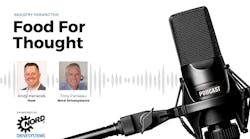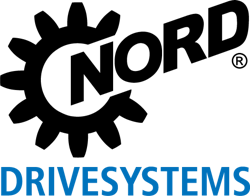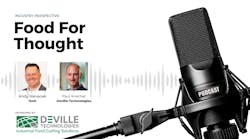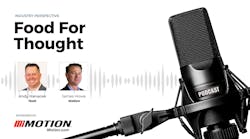The unsung heroes of a processing plant’s operation, drives and motors keep operations running effectively and efficiently — and often aren’t noticed unless they’re not performing up to standards for throughput, efficiency and food safety. Tony Pariseau, key market specialist for food and beverage at Nord Drivesystems, joined us recently to share what the team at Nord views as pushing the envelope of innovation in drive technology in the food & beverage industry today.
Transcript
Food Processing: What are the trends that you’re seeing within that industry regarding drive technology?
Tony Pariseau: What we’ve seen recently is the increased awareness of the benefits of the hygienic washdown solutions that are out there, as well as the increase of overall automation needs from the end customers in the food industry for the demanding production requirements that they’re seeing today. Customers are looking for the added protection of IP69K to ensure the longevity of their gearbox and increase their overall return on investment. So, these end users have a lot of products that are involved and they have to be sanitized and make sure that they’re upholding the USDA or FDA requirements that are implemented on their product on a daily basis. We’re also seeing increased investments or interest in our top-of-the-line washdown surface treatments. Nord has a product that can handle the washdown treatments and caustic washdown requirements that are out there. We call this nsd tupH, and it’s a replacement for traditional stainless-steel drives and motors. The nsd tupH product meets the requirements for IP69K and stands up to the high pressure, high heat and caustic washdown environments that are needed within the food & beverage industry. The IP69K rating means a piece of equipment can withstand intensive cleaning with high-pressure, high-temperature jets.
TP: While washdown is by far the main topic as we just discussed, not every application requires a heavy washdown scenario. We’re seeing an increase in the automation needs for food products such as dried foods, bakery products, ready meals, beverages, canned foods and confectionary. There’s many more out there, but those are probably the main type of products we’re seeing. And while Nord offers a wide variety of configuration and surface treatment options, it’s becoming increasingly important as food processing applications evolve with all the sanitation that’s out there. Food and beverage applications are diverse and require a variety of gear units, including parallel shafts. We’ve got the two-stage right-angle. We’ve got right-angle helical-worm products that we’re seeing in the food and beverage industry. We also have a cast-iron type of right-angle helical bevel product and an inline product. A lot of these products can utilize nsd tupH, but many are painted with our high-end, quality paint systems. They might need to be washed down, but they’re not a caustic washdown, so the paint systems hold up very, very well with just a high-pressure sprayer.
FP: Let’s shift gears here and talk about the packaging side a little bit. What are you seeing in terms of trends on the side of packaging?
TP: Actually, packaging is another large area that Nord is really focusing on. In the packaging industry, we’re experiencing relatively about 4% to 6% overall growth worldwide. And of course, it’s constantly changing to ensure sustainability and competitiveness. So there are multiple different types of packaging applications, especially the end-of-line packaging, and they are becoming very precisely controlled. Sophisticated processes require numerous drive system configurations and control options.
Our products can handle many, many different types of applications. There’s increasingly a call for modularity, decentralized concepts to reduce system variance and simplify the maintenance. Maintenance is a big factor in the marketplace. They have to keep it relatively easy out there so the machines can be maintained. We’ve got multiple different developments in drive technology, allowing precise control to take place without the need of conventional servo components.
Also, we’re trying to reduce the overall project costs, and our systems can help with that. The palletizers, the de-palletizers, the strapping and wrapping machines, automation transports and conveyors are being put into play more than ever to increase operational efficiency and ultimately save companies time and money. That’s our ultimate goal on the packaging end. We focus mainly on the end-of-line packaging, and each type of equipment has its own requirements to consider when specifying drive systems. We’ve got applications engineers on staff that can help walk through the applications with the end users or the OEM machine builders to make sure they’re getting the correct product for the application.
FP: What concerns do you hear about when it comes to energy efficiency and drive systems?
TP: Everybody’s talking about green, and energy efficiency is a huge concern in multiple different industries. In the food and beverage industry, we’re not seeing the large demand for the efficiency levels and the efficiency savings, although in any of these production plants, they want to save energy. There’s no question. Nord really sees energy efficiencies in the intralogistics industry. That’s a big factor that we’re seeing along with strict energy cost requirements. In the food industry, it’s definitely a concern, but it’s not to the levels of the intralogistics as of yet, but it will get there. So with that said, I truly believe in the coming years in the food and beverage industry, it’s going to be a very large concern, where today it’s more of a nicety.
Drive systems are a major contributing factor for the overall efficiencies of the system. And the need to plan for conversion to a high-efficiency system is on the horizon when it comes to the food and beverage industry. It’s already here for the intralogistics facilities, such as these large Walmart distribution centers or Amazon distribution centers, where there’s thousands and thousands of gearboxes and gear motors in there. So those are in high demand. Within the food industry, we know the energy efficiencies are coming, and Nord is more than ready to handle their applications in the future.



